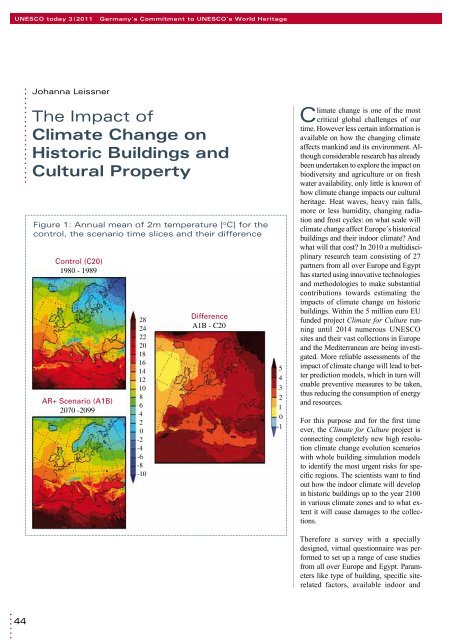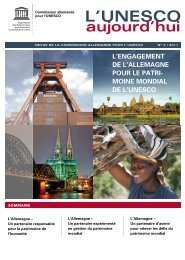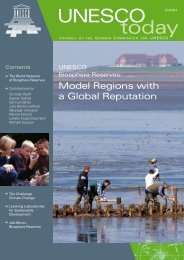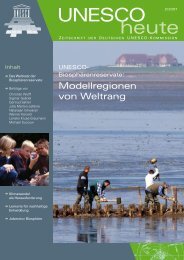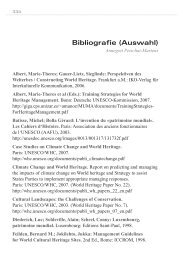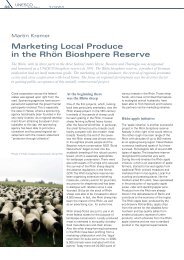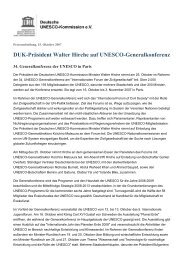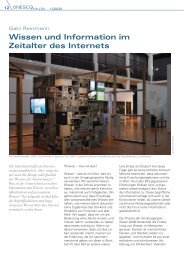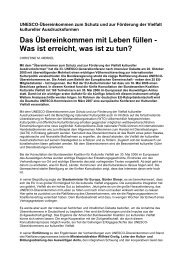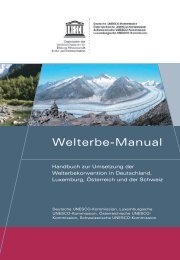Download - UNESCO Deutschland
Download - UNESCO Deutschland
Download - UNESCO Deutschland
Create successful ePaper yourself
Turn your PDF publications into a flip-book with our unique Google optimized e-Paper software.
UNesCO today 3 | 2011 germany’s Commitment to UNesCO’s World Heritage<br />
44<br />
Johanna leissner<br />
The Impact of<br />
Climate Change on<br />
Historic buildings and<br />
Cultural Property<br />
Figure 1: annual mean of 2m temperature [ o C] for the<br />
control, the scenario time slices and their difference<br />
Control (C20)<br />
1980 - 1989<br />
AR+ Scenario (A1B)<br />
2070 -2099<br />
28<br />
24<br />
22<br />
20<br />
18<br />
16<br />
14<br />
12<br />
10<br />
8<br />
6<br />
4<br />
2<br />
0<br />
-2<br />
-4<br />
-6<br />
-8<br />
-10<br />
Difference<br />
A1B - C20<br />
5<br />
4<br />
3<br />
2<br />
1<br />
0<br />
-1<br />
Climate change is one of the most<br />
critical global challenges of our<br />
time. However less certain information is<br />
available on how the changing climate<br />
affects mankind and its environment. Although<br />
considerable research has already<br />
been undertaken to explore the impact on<br />
biodiversity and agriculture or on fresh<br />
water availability, only little is known of<br />
how climate change impacts our cultural<br />
heritage. Heat waves, heavy rain falls,<br />
more or less humidity, changing radiation<br />
and frost cycles: on what scale will<br />
climate change affect Europe´s historical<br />
buildings and their indoor climate? And<br />
what will that cost? In 2010 a multidisciplinary<br />
research team consisting of 27<br />
partners from all over Europe and Egypt<br />
has started using innovative technologies<br />
and methodologies to make substantial<br />
contributions towards estimating the<br />
impacts of climate change on historic<br />
buildings. Within the 5 million euro EU<br />
funded project Climate for Culture running<br />
until 2014 numerous <strong>UNESCO</strong><br />
sites and their vast collections in Europe<br />
and the Mediterranean are being investigated.<br />
More reliable assessments of the<br />
impact of climate change will lead to better<br />
prediction models, which in turn will<br />
enable preventive measures to be taken,<br />
thus reducing the consumption of energy<br />
and resources.<br />
For this purpose and for the first time<br />
ever, the Climate for Culture project is<br />
connecting completely new high resolution<br />
climate change evolution scenarios<br />
with whole building simulation models<br />
to identify the most urgent risks for specific<br />
regions. The scientists want to find<br />
out how the indoor climate will develop<br />
in historic buildings up to the year 2100<br />
in various climate zones and to what extent<br />
it will cause damages to the collections.<br />
Therefore a survey with a specially<br />
designed, virtual questionnaire was performed<br />
to set up a range of case studies<br />
from all over Europe and Egypt. Parameters<br />
like type of building, specific siterelated<br />
factors, available indoor and


